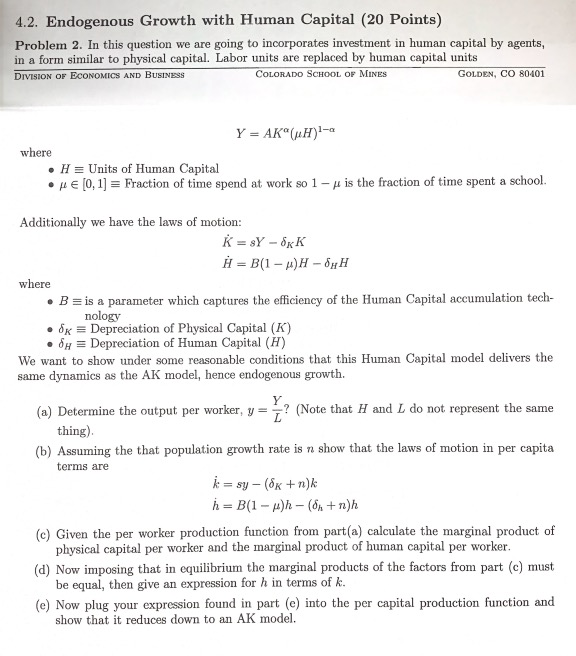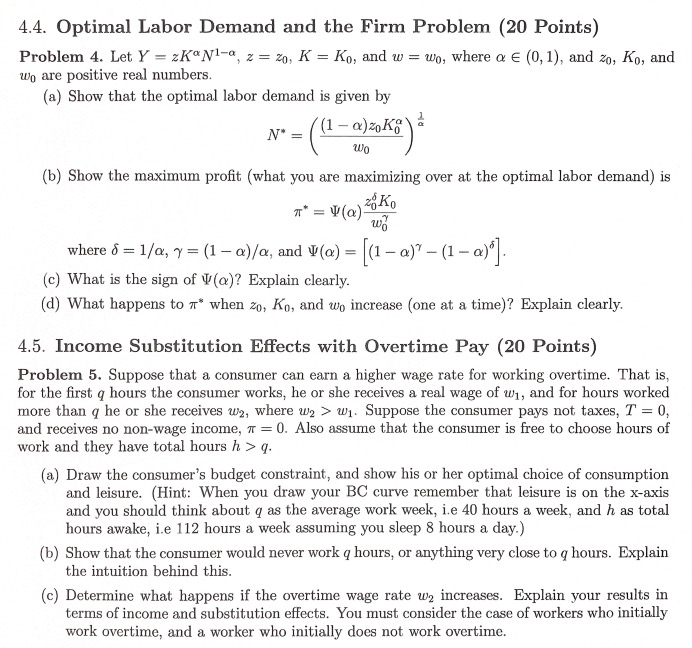Answered step by step
Verified Expert Solution
Question
1 Approved Answer
I don't need 4.5, thank you:) 4.2. Endogenous Growth with Human Capital (20 Points) Problem 2. In this question we are going to incorporates investment


I don't need 4.5, thank you:)
4.2. Endogenous Growth with Human Capital (20 Points) Problem 2. In this question we are going to incorporates investment in human capital by agents, in a form similar to physical capital. Labor units are replaced by human capital units DIVISION OF ECONOMICS AND BUSINESS COLORADO SCHOOL OF MINES GOLDEN, CO 80401 Y = AK"(H) - where H = Units of Human Capital [0,1] = Fraction of time spend at work so 1 - H is the fraction of time spent a school. Additionally we have the laws of motion: K = $Y - OK = B(1 - x)H-8H where B = is a parameter which captures the efficiency of the Human Capital accumulation tech- nology 8x = Depreciation of Physical Capital (K) 88 = Depreciation of Human Capital (H) We want to show under some reasonable conditions that this Human Capital model delivers the same dynamics as the AK model, hence endogenous growth. Y (a) Determine the output per worker, y = {? (Note that H and L do not represent the same thing) (b) Assuming the that population growth rate is n show that the laws of motion in per capita terms are k=sy - (8k+n)k h= B(1 - wh - (8 + noh (c) Given the per worker production function from part(a) calculate the marginal product of physical capital per worker and the marginal product of human capital per worker. (d) Now imposing that in equilibrium the marginal products of the factors from part (c) must be equal, then give an expression for h in terms of k. (e) Now plug your expression found in part (e) into the per capital production function and show that it reduces down to an AK model. 4.4. Optimal Labor Demand and the Firm Problem (20 Points) Problem 4. Let Y = 2KNl-a, z = zo, K = Ko, and w = wo, where a (0,1), and zo, Ko, and Wo are positive real numbers. (a) Show that the optimal labor demand is given by (1 - a)zoK N" wo (b) Show the maximum profit (what you are maximizing over at the optimal labor demand) is ** = v(a)KO where 8 = 1/a, y = (1 a)/a, and V(a) = [(1 a)? (1 a)"]. (c) What is the sign of (a)? Explain clearly. (d) What happens to 7* when zo, Ko, and wo increase (one at a time)? Explain clearly. 4.5. Income Substitution Effects with Overtime Pay (20 Points) Problem 5. Suppose that a consumer can earn a higher wage rate for working overtime. That is, for the first q hours the consumer works, he or she receives a real wage of w1, and for hours worked more than q he or she receives w2, where W2 > Wi. Suppose the consumer pays not taxes, T = 0, and receives no non-wage income, 1 = 0. Also assume that the consumer is free to choose hours of work and they have total hours h > q. (a) Draw the consumer's budget constraint, and show his or her optimal choice of consumption and leisure. (Hint: When you draw your BC curve remember that leisure is on the x-axis and you should think about q as the average work week, i.e 40 hours a week, and h as total hours awake, i.e 112 hours a week assuming you sleep 8 hours a day.) (b) Show that the consumer would never work q hours, or anything very close to q hours. Explain the intuition behind this. (c) Determine what happens if the overtime wage rate w, increases. Explain your results in terms of income and substitution effects. You must consider the case of workers who initially work overtime, and a worker who initially does not work overtime. 4.2. Endogenous Growth with Human Capital (20 Points) Problem 2. In this question we are going to incorporates investment in human capital by agents, in a form similar to physical capital. Labor units are replaced by human capital units DIVISION OF ECONOMICS AND BUSINESS COLORADO SCHOOL OF MINES GOLDEN, CO 80401 Y = AK"(H) - where H = Units of Human Capital [0,1] = Fraction of time spend at work so 1 - H is the fraction of time spent a school. Additionally we have the laws of motion: K = $Y - OK = B(1 - x)H-8H where B = is a parameter which captures the efficiency of the Human Capital accumulation tech- nology 8x = Depreciation of Physical Capital (K) 88 = Depreciation of Human Capital (H) We want to show under some reasonable conditions that this Human Capital model delivers the same dynamics as the AK model, hence endogenous growth. Y (a) Determine the output per worker, y = {? (Note that H and L do not represent the same thing) (b) Assuming the that population growth rate is n show that the laws of motion in per capita terms are k=sy - (8k+n)k h= B(1 - wh - (8 + noh (c) Given the per worker production function from part(a) calculate the marginal product of physical capital per worker and the marginal product of human capital per worker. (d) Now imposing that in equilibrium the marginal products of the factors from part (c) must be equal, then give an expression for h in terms of k. (e) Now plug your expression found in part (e) into the per capital production function and show that it reduces down to an AK model. 4.4. Optimal Labor Demand and the Firm Problem (20 Points) Problem 4. Let Y = 2KNl-a, z = zo, K = Ko, and w = wo, where a (0,1), and zo, Ko, and Wo are positive real numbers. (a) Show that the optimal labor demand is given by (1 - a)zoK N" wo (b) Show the maximum profit (what you are maximizing over at the optimal labor demand) is ** = v(a)KO where 8 = 1/a, y = (1 a)/a, and V(a) = [(1 a)? (1 a)"]. (c) What is the sign of (a)? Explain clearly. (d) What happens to 7* when zo, Ko, and wo increase (one at a time)? Explain clearly. 4.5. Income Substitution Effects with Overtime Pay (20 Points) Problem 5. Suppose that a consumer can earn a higher wage rate for working overtime. That is, for the first q hours the consumer works, he or she receives a real wage of w1, and for hours worked more than q he or she receives w2, where W2 > Wi. Suppose the consumer pays not taxes, T = 0, and receives no non-wage income, 1 = 0. Also assume that the consumer is free to choose hours of work and they have total hours h > q. (a) Draw the consumer's budget constraint, and show his or her optimal choice of consumption and leisure. (Hint: When you draw your BC curve remember that leisure is on the x-axis and you should think about q as the average work week, i.e 40 hours a week, and h as total hours awake, i.e 112 hours a week assuming you sleep 8 hours a day.) (b) Show that the consumer would never work q hours, or anything very close to q hours. Explain the intuition behind this. (c) Determine what happens if the overtime wage rate w, increases. Explain your results in terms of income and substitution effects. You must consider the case of workers who initially work overtime, and a worker who initially does not work overtimeStep by Step Solution
There are 3 Steps involved in it
Step: 1

Get Instant Access to Expert-Tailored Solutions
See step-by-step solutions with expert insights and AI powered tools for academic success
Step: 2

Step: 3

Ace Your Homework with AI
Get the answers you need in no time with our AI-driven, step-by-step assistance
Get Started


